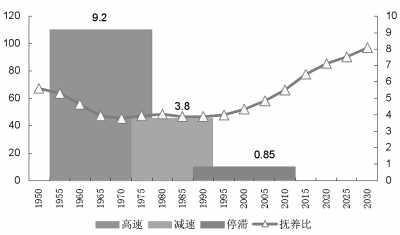
 |
| Japanese economy trend before and after the disappearance of the demographic dividend..(People's Daily/Photo) |
Inflection point of demographic dividend appears (Part I)
Inappropriate measures to deal with demographic dividend
China’s economy development should not over expand by means of increasing investment.
Disappearing trend of demographic dividend will result in a slowdown of China’s economy growth. Therefore, we should face and accept the trend, and respond positively. Cai Fang said solutions should be divided in two parts: measures China should do and measures China should not do.
China should not increase the economic growth rate by over expanding investment and increasing demand. Some people may propose increasing infrastructure investment in central and western regions. These measures had been successful before, but overstepping the growth rate will cause serious consequences like excess capacity, currency inflation, industrial structure deviating from comparative advantage, natural resources exceeding bearing capacity, etc, Cai said.
In this respect, Cai said, China should use Japan’s experiences as references. Japan’s dependency ratio continuously decreased from 1950s to 1970s, and the economy growth rate increased 9 percent during those two decades. After the dependency ratio declined to a low point and sustained at the low level for 20 years, Japan’s economy growth rate dropped to 3.8 percent. Neither the government nor Japanese people were willing to see the economy deceleration. Therefore measures were taken to improve economy growth, like loose monetary policy, expanding facial policy, implementing regional development policy, industrial policy and macro-economy stimulus plans. After 1990s, the dependency ratio began to rise, the demographic dividend has disappeared. But the above mentioned stimulus policies have generated severe bubble economy, and the annual growth rate of Japan declined to 0.9 percent for 20 years.
Right measures
Although potential growth rate cannot be surpassed, it can be scientifically increased though reformation.
Cai said although quantity of labor force is reduced, labor force participation can be improved. About 160 million migrant workers do not have urban residence certificates. They generally retire and return home at their 40s because they cannot enjoy the basic public service. If household registration system is reformed and migrant workers can retire at their 60s, participation rate will be increased and the potential growth rate will be improved.
Cai added if China breaks monopoly by supporting medium-sized and small enterprises, making equal competition among companies, the potential growth rate can also be increased.
Because of the disappearing trend of demographic dividend, should China adjust the family planning policy? Cai said even China adjusts family planning policy, it takes 15 years or even longer time for forming working-age population, which cannot change the situation of the decline of working-age population. But Cai thought that the bottom line of China’s policy should allow two children in each family.
Edited and translated by Ma Xi, People's Daily Online
Read the Chinese version: 人口红利拐点已现(经济大势)
Source: People's Daily
















 Buildings collapse after subsidence in S China
Buildings collapse after subsidence in S China


![]()
